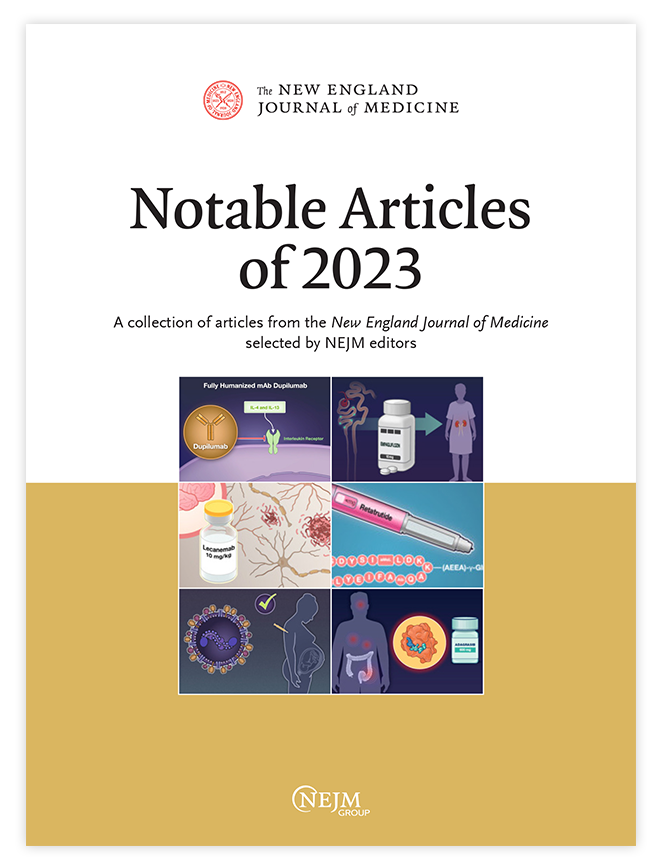Fidanacogene Elaparvovec for Hemophilia B - A Multiyear Follow-up Study.
IF 96.2
1区 医学
Q1 MEDICINE, GENERAL & INTERNAL
引用次数: 0
Abstract
BACKGROUND Treatment with fidanacogene elaparvovec, a recombinant adeno-associated virus (AAV) vector developed for the treatment of hemophilia B, led to sustained expression of the high-activity factor IX variant (FIX-R338L, or FIX-Padua) in a phase 1-2a study. The long-term safety and efficacy of this treatment are not known. METHODS In a 12-month study, 15 participants with severe or moderately severe hemophilia B (factor IX coagulant activity, ≤2% of the normal value) received fidanacogene elaparvovec at a dose of 5×1011 vector genomes (vg) per kilogram of body weight; thereafter, participants could enroll in a 5-year follow-up study. Safety end points included adverse events and changes in laboratory measures. Efficacy end points included the annualized rate of treated bleeding events (annualized bleeding rate) and factor IX activity. RESULTS A total of 14 participants provided consent and completed at least 3 years of follow-up (median, 5.5; range 3 to 6); participation was ongoing among 8 at the data cutoff. None of the participants reported treatment-related adverse events after year 1. Throughout follow-up, nine serious adverse events were noted in 4 participants; none were thrombotic or treatment-related. No factor IX inhibitors were detected. Throughout follow-up, mean factor IX activity was in the mild hemophilia range; the mean annualized bleeding rate was less than 1, and 10 participants had no treated bleeding episodes. Surveillance liver ultrasounds obtained from year 1 onward showed no evidence of cancer but showed steatosis in 4 participants who had weight gain and elevated aminotransferase levels (maximum alanine aminotransferase level, 77 U per liter). One participant with a history of hepatitis C, hepatitis B, human immunodeficiency virus infection, and an elevated body-mass index had progression of underlying advanced liver fibrosis. A total of 13 surgical procedures were performed in 8 participants; exogenous factor IX was administered for 10 procedures, and no associated unexpected bleeding complications occurred. CONCLUSIONS Fidanacogene elaparvovec was associated with no or only low-grade adverse effects over a period of 3 to 6 years. Efficacy was maintained in the long term at 5×1011 vg per kilogram, one of the lowest intravenous doses of AAV used for any indication. (Funded by Pfizer; ClinicalTrials.gov number, NCT03307980.).非达那原Elaparvovec治疗血友病B - A多年随访研究。
背景:在一项1-2a期研究中,使用重组腺相关病毒(AAV)载体fidanacogene elaparvovec治疗血友病B,导致高活性因子IX变体(FIX-R338L,或FIX-Padua)持续表达。这种治疗的长期安全性和有效性尚不清楚。方法在一项为期12个月的研究中,15名患有重度或中度血友病B(因子IX凝血活性≤正常值的2%)的参与者以每公斤体重5×1011载体基因组(vg)的剂量接受了fidanacogene elaparvovec;之后,参与者可以参加一项为期5年的随访研究。安全终点包括不良事件和实验室测量的变化。疗效终点包括治疗出血事件的年化率(年化出血率)和因子IX活性。结果:共有14名参与者同意并完成了至少3年的随访(中位数,5.5;范围3至6);在数据截止时,有8人正在参与。1年后没有参与者报告与治疗相关的不良事件。在整个随访过程中,4名参与者出现了9次严重不良事件;没有血栓性或治疗相关。未检测到因子IX抑制剂。在整个随访过程中,因子IX的平均活性在轻度血友病范围内;平均年化出血率小于1,10名参与者没有出血治疗。从第一年开始的肝脏超声监测显示没有癌症的证据,但在4名体重增加和转氨酶水平升高的参与者中显示脂肪变性(最高丙氨酸转氨酶水平为每升77 U)。一名有丙型肝炎、乙型肝炎、人类免疫缺陷病毒感染史和身体质量指数升高的参与者有潜在的晚期肝纤维化进展。8名参与者共接受了13次外科手术;外源性因子IX治疗10次,未发生意外出血并发症。结论:在3 - 6年的时间里,非达那单抗没有或只有低程度的不良反应。长期疗效维持在5×1011 vg / kg,这是所有适应症中静脉注射AAV的最低剂量之一。(辉瑞投资;ClinicalTrials.gov号码:NCT03307980)。
本文章由计算机程序翻译,如有差异,请以英文原文为准。
求助全文
约1分钟内获得全文
求助全文
来源期刊

New England Journal of Medicine
医学-医学:内科
CiteScore
145.40
自引率
0.60%
发文量
1839
审稿时长
1 months
期刊介绍:
The New England Journal of Medicine (NEJM) stands as the foremost medical journal and website worldwide. With an impressive history spanning over two centuries, NEJM boasts a consistent publication of superb, peer-reviewed research and engaging clinical content. Our primary objective revolves around delivering high-caliber information and findings at the juncture of biomedical science and clinical practice. We strive to present this knowledge in formats that are not only comprehensible but also hold practical value, effectively influencing healthcare practices and ultimately enhancing patient outcomes.
 求助内容:
求助内容: 应助结果提醒方式:
应助结果提醒方式:


